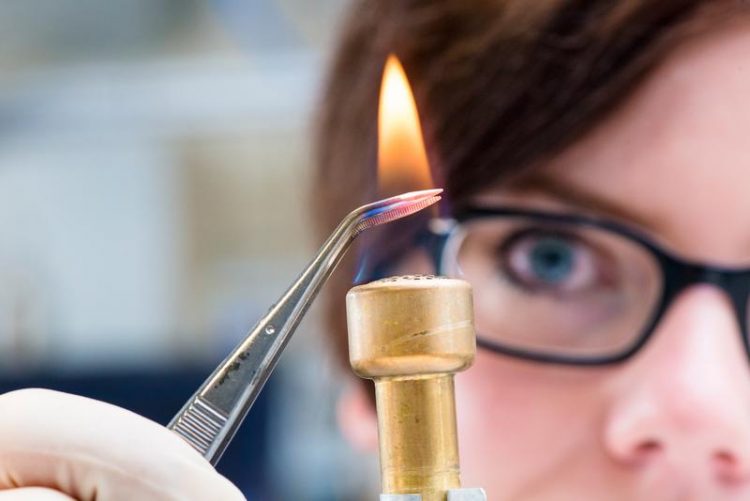Non-damaging and efficient: plasma steriliser for medical and aerospace applications

Plasma – the state of matter with the highest energy level – is familiar to many in nature in the form of fire. Using cold plasmas, many items can be efficiently sterilised. RUBIN, photo: Gorczany
Perfect fit for medical applications
Stapelmann designed the sterilisation chamber as a drawer with a surface in DIN-A4 format to hold standard tablets for medical instruments. The drawer may also be used as a sterile container. “You can, for example, put a set that’s going to be used in an appendectomy into the device, sterilise it and store the closed container in the cupboard right until surgery,” explains the researcher.
Compared with traditional processes, plasma sterilisation is more energy saving, faster and does not require any harmful radiation or carcinogenic chemicals. Unlike autoclaves, which apply moist heat, the process can be deployed for synthetic components, and it does not damage metal items which an autoclave blunts within a short space of time. A prototype of the steriliser is already available. What is now missing is an industrial partner who will make the product market-ready.
Germ-free in space
In order to prevent germs from the Earth from getting into space, and germs from space from getting to Earth, it is standard practice to sterilise all aerospace materials. However, not all pathogens are destroyed by this multi-stage process.
In collaboration with the German Aerospace Center, Katharina Stapelmann tested her method for metal screws which were riddled with the spores of the particularly stubborn bacterium Bacillus pumilis SAFR032.
This bacteria stem has demonstrated the to-date highest resistance against traditional sterilisation methods, such as autoclaves, chemical treatment or UV radiation. The plasma treatment, however, destroyed all germs within the space of only five minutes at a temperature of 60 degrees centigrade.
Detailed article in the science magazine RUBIN
A detailed article with pictures can be found in the online magazine RUBIN, the RUB’s science magazine: http://rubin.rub.de/en/germ-free-space. Text and images in the download page are free for use for editorial purposes, provided the relevant copyright notice is included. You would like to receive a notification when new RUBIN articles are published? Then subscribe to our news feed at http://rubin.rub.de/feed/rubin-en.rss.
About Katharina Stapelmann
Katharina Stapelmann was appointed Junior Professor at the Faculty of Electrical Engineering and Information Technology on February 1, 2015, and she heads the group “Plasma Technology in Biomedical Applications”. In December 2013, she obtained her doctorate summa cum laude with the thesis “Plasma technical and microbiological characterization of newly developed VHF plasmas”. Following her graduation in Electrical Engineering and Information Technology, she worked since 2009 as researcher at the Institute for Electrical Engineering and Plasma Technology, headed by Prof Dr-Ing. Peter Awakowicz, at RUB.
Further information
Junior Professor Dr-Ing. Katharina Stapelmann, Institute for Electrical Engineering and Plasma Technology, Faculty of Electrical Engineering and Information Technology at the Ruhr-Universität, 44780 Bochum, Germany, phone: +49/234/32-29445, email: stapelmann@aept.rub.de
One click away
More plasma research in RUBIN
http://rubin.rub.de/en/making-synthetic-materials-more-impervious
Media Contact
All latest news from the category: Power and Electrical Engineering
This topic covers issues related to energy generation, conversion, transportation and consumption and how the industry is addressing the challenge of energy efficiency in general.
innovations-report provides in-depth and informative reports and articles on subjects ranging from wind energy, fuel cell technology, solar energy, geothermal energy, petroleum, gas, nuclear engineering, alternative energy and energy efficiency to fusion, hydrogen and superconductor technologies.
Newest articles

Webb captures top of iconic horsehead nebula in unprecedented detail
NASA’s James Webb Space Telescope has captured the sharpest infrared images to date of a zoomed-in portion of one of the most distinctive objects in our skies, the Horsehead Nebula….

Cost-effective, high-capacity, and cyclable lithium-ion battery cathodes
Charge-recharge cycling of lithium-superrich iron oxide, a cost-effective and high-capacity cathode for new-generation lithium-ion batteries, can be greatly improved by doping with readily available mineral elements. The energy capacity and…

Novel genetic plant regeneration approach
…without the application of phytohormones. Researchers develop a novel plant regeneration approach by modulating the expression of genes that control plant cell differentiation. For ages now, plants have been the…





















